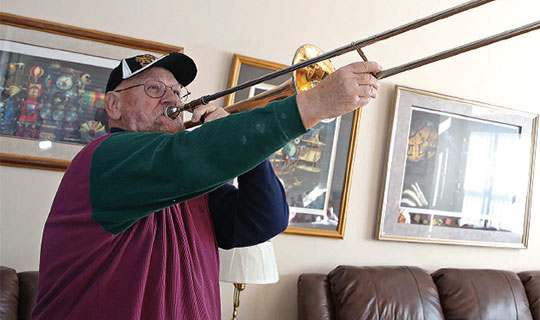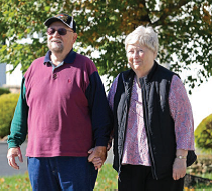“I’m much more energetic. I do a three-mile hike several times a week, work in my garden and take care of things around the house. I no longer hesitate to do things, like I used to.”

An Innovative Heart Valve Replacement Surgery Lets a Local Man Get Back to His Band
Martin Haindl, 79, a retired physics professor, is an amateur trombonist – but shortness of breath due to a narrowing of his heart valve silenced the Manchester Township resident’s horn for several years.
“It just took so much wind for Martin to blow his trombone that he stopped playing,” says Priscilla, his wife of 48 years. Martin’s cardiologist sent him to the heart team at Saint Barnabas Medical Center (SBMC). The team there was offering an innovative treatment for his condition, known as transcatheter aortic valve replacement (TAVR).
“Today, he’s practicing with the band every week, and even performs in public!” Priscilla says.
A Narrowing Valve
Martin had aortic stenosis, a common but serious valve disease that often develops during aging. With this condition, the aortic valve narrows, restricting the flow of blood from the heart into the main artery (aorta) and from there to the rest of the body. As a result, the heart has to work harder to pump blood. Symptoms include chest pain, fatigue, dizziness and shortness of breath.
For years, the primary treatment for severe aortic stenosis was valve replacement through open-heart surgery, a major operation in which the chest is cut open. In 2012, the Food and Drug Administration (FDA) approved TAVR as an alternative. In this minimally invasive surgery, a replacement valve is inserted into the body via a catheter in the leg and guided to the heart.
 But the FDA had approved TAVR only for people who were deemed at risk for not surviving major surgery. That meant that patients like Martin, who needed a new valve but didn’t have other major health risks, had only open-heart surgery as a surgical option.
But the FDA had approved TAVR only for people who were deemed at risk for not surviving major surgery. That meant that patients like Martin, who needed a new valve but didn’t have other major health risks, had only open-heart surgery as a surgical option.
It was Martin’s good fortune that when he needed a new valve, specialists at SBMC were participating in a large-scale study that compared outcomes for the TAVR procedure with outcomes for open-heart surgery in patients at lower risk. He received his new valve in July and went home the next day, where he resumed an active lifestyle.
Due in part to results like Martin’s at SBMC, the FDA has expanded its approval of TAVR for use in low-risk surgical patients.
“The new study confirmed what our experience here at Saint Barnabas suggested, that TAVR and open-heart surgery have similar outcomes for valve replacement,” says Sabino Torre, MD, Director of the Cardiac Catheterization Lab at SBMC and a member of RWJBarnabas Health medical group.
“The TAVR patients had less bleeding and fewer arrhythmias and strokes, and a much faster recovery. Due to research done here and elsewhere on TAVR for low-risk patients, our specialists alone will be able to offer TAVR for several thousand patients in the coming years, twice as many as today,” says Dr. Torre.
Advanced Tools
So far, the TAVR teams at RWJBarnabas Health—which include specialists at SBMC, Newark Beth Israel Medical Center and Robert Wood Johnson University Hospital in New Brunswick—have repaired the valves of more than a thousand patients, with some of the best outcomes in the U.S. This includes patients getting back to normal activities in one to two days, versus one to two weeks after open-heart surgery, Dr. Torre says.
The recovery benefits come from the way the new heart valve is placed. Using tiny tools and specialized techniques, a TAVR specialist folds an artificial replacement valve so that it is very small, secures it to the tip of the catheter (a thin tube) and then threads it up to the heart.
Physicians use state-of-the-art imaging technology to see exactly where to place the new valve and then expand it.
Despite its benefits, TAVR is not for every patient, and heart surgery is sometimes the best option, Dr. Torre says. Physicians make recommendations on a case-by-case basis.
“Looking ahead, we are also evaluating whether TAVR can be used before patients ever have any symptoms, and possibly for patients with heart failure,” Dr. Torre says. “It’s exciting to see how much the technology and research is improving the range of heart valves we can repair.”
For Martin, the fatigue and shortness of breath he’d had for years disappeared in short order. He no longer avoids stairs, and he no longer wakes up breathless. Instead, he sleeps through the night.
“I’m much more energetic,” he says. “I do a three-mile hike several times a week, work in my garden and take care of things around the house. I no longer hesitate to do things, like I used to.”
Just months after the procedure at SBMC, he rejoined the band. “My wind is pretty good,” he says modestly. And the band is glad to have him back for their regular gigs.
To learn more about transcatheter aortic valve replacement at Saint Barnabas Medical Center, call 888-724-7123 or visit Transcatheter Aortic Valve Replacement.